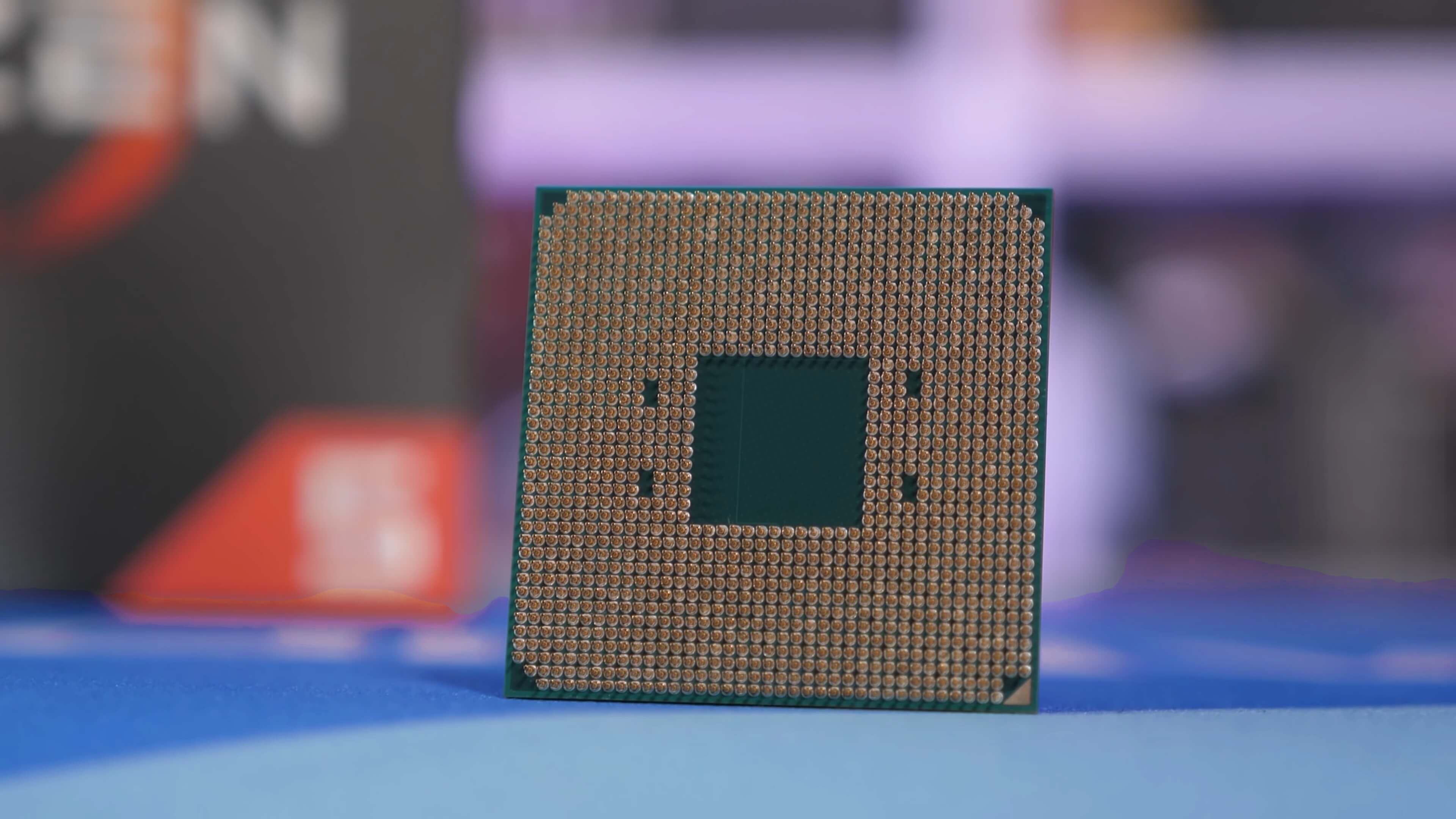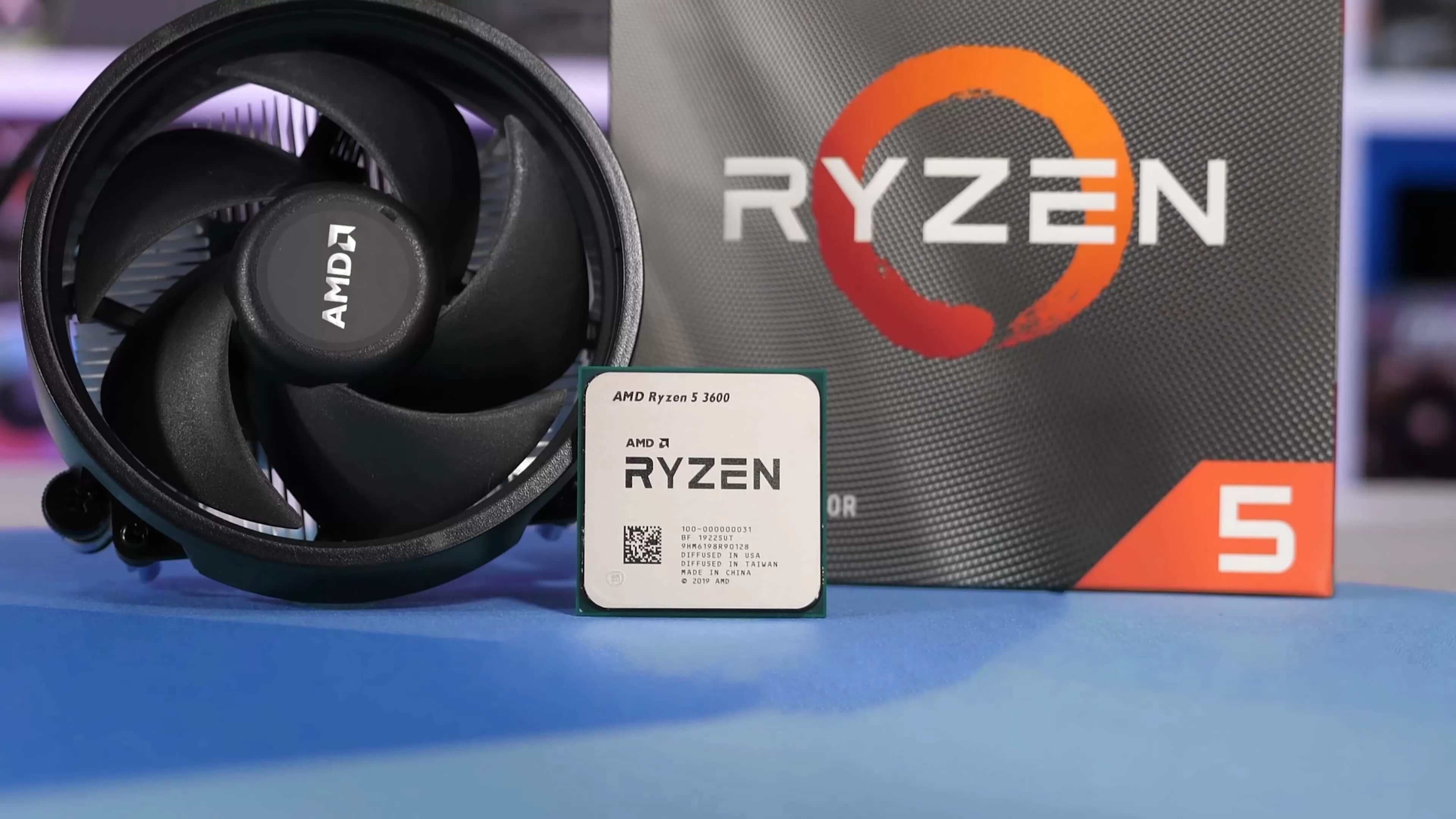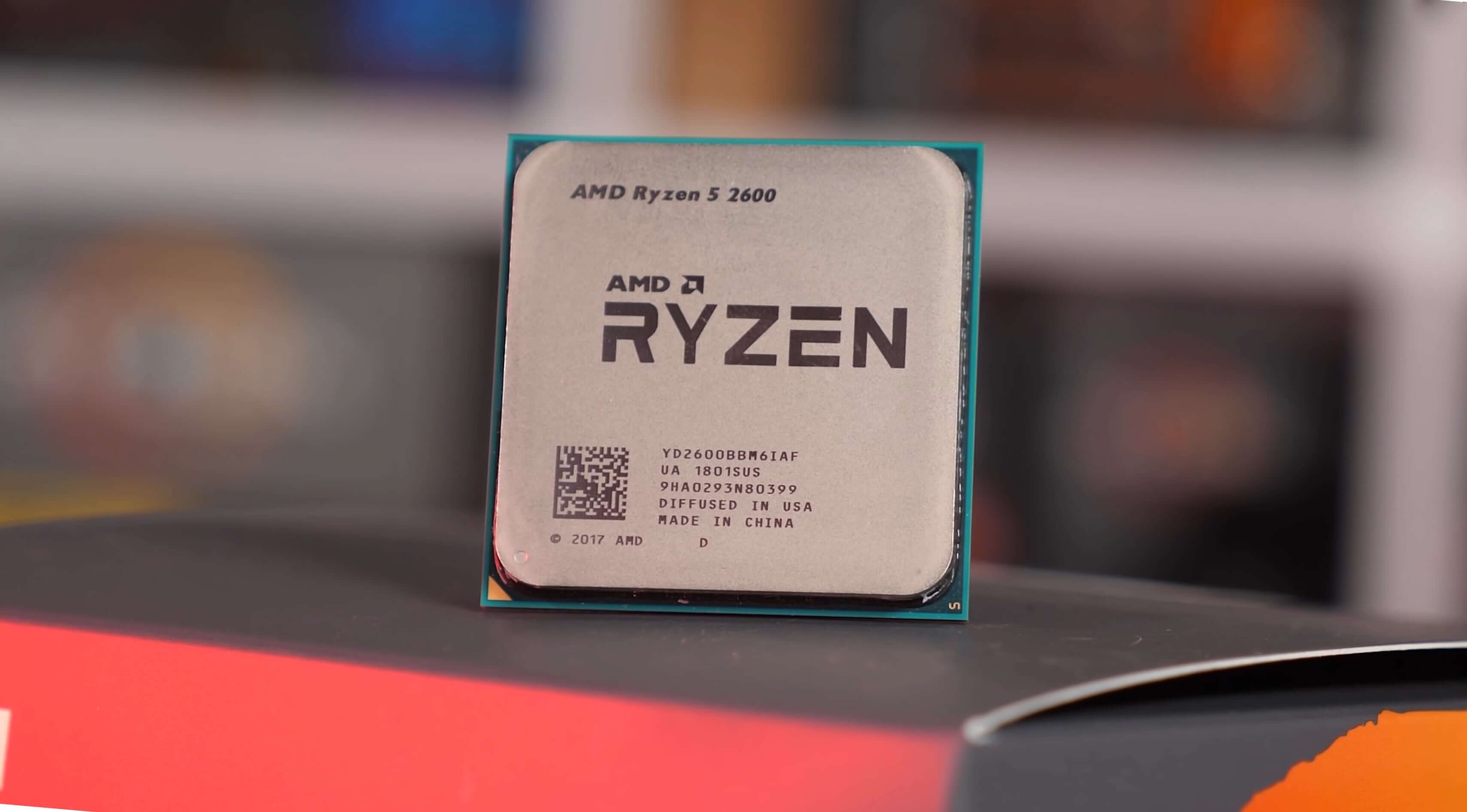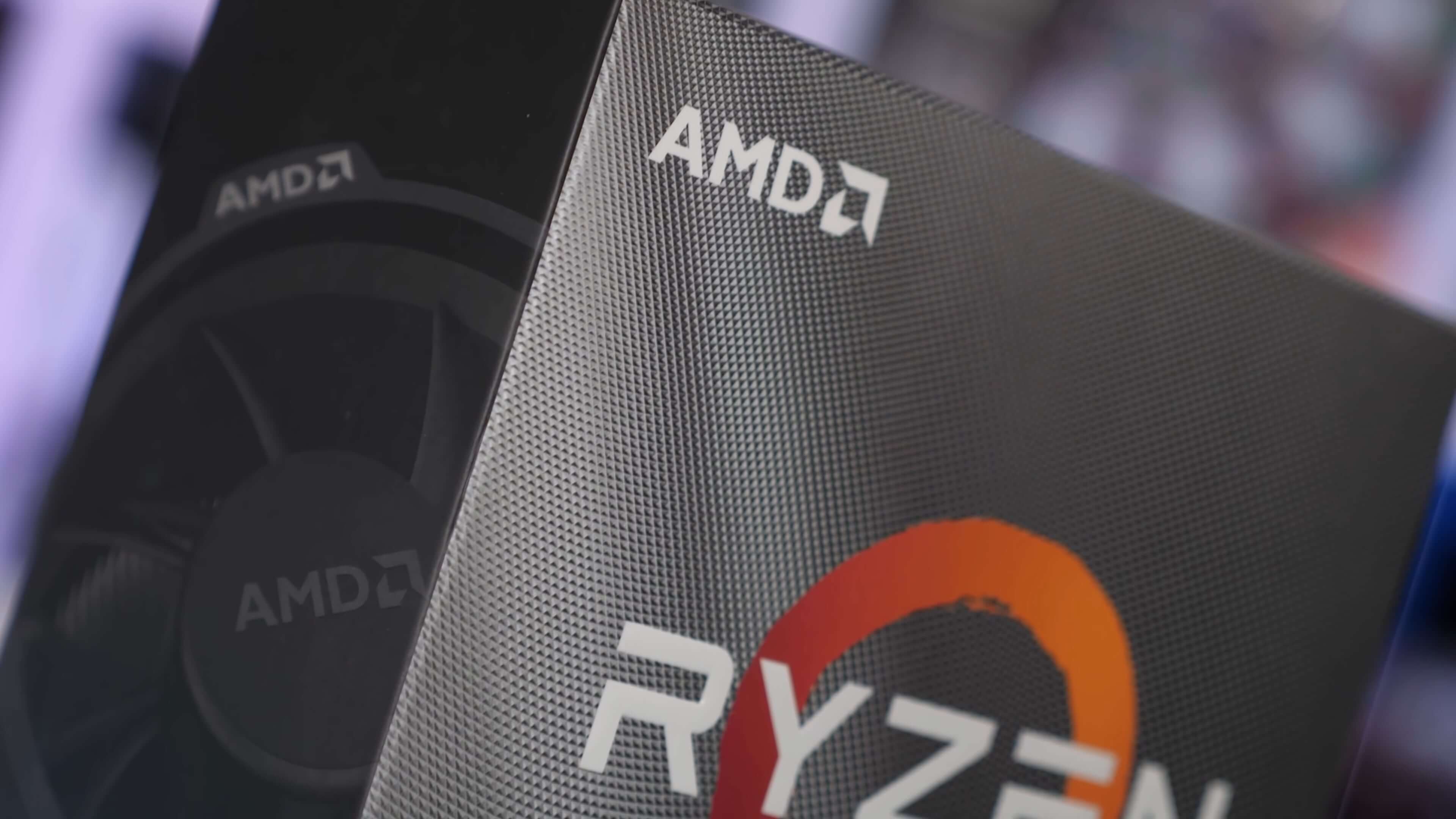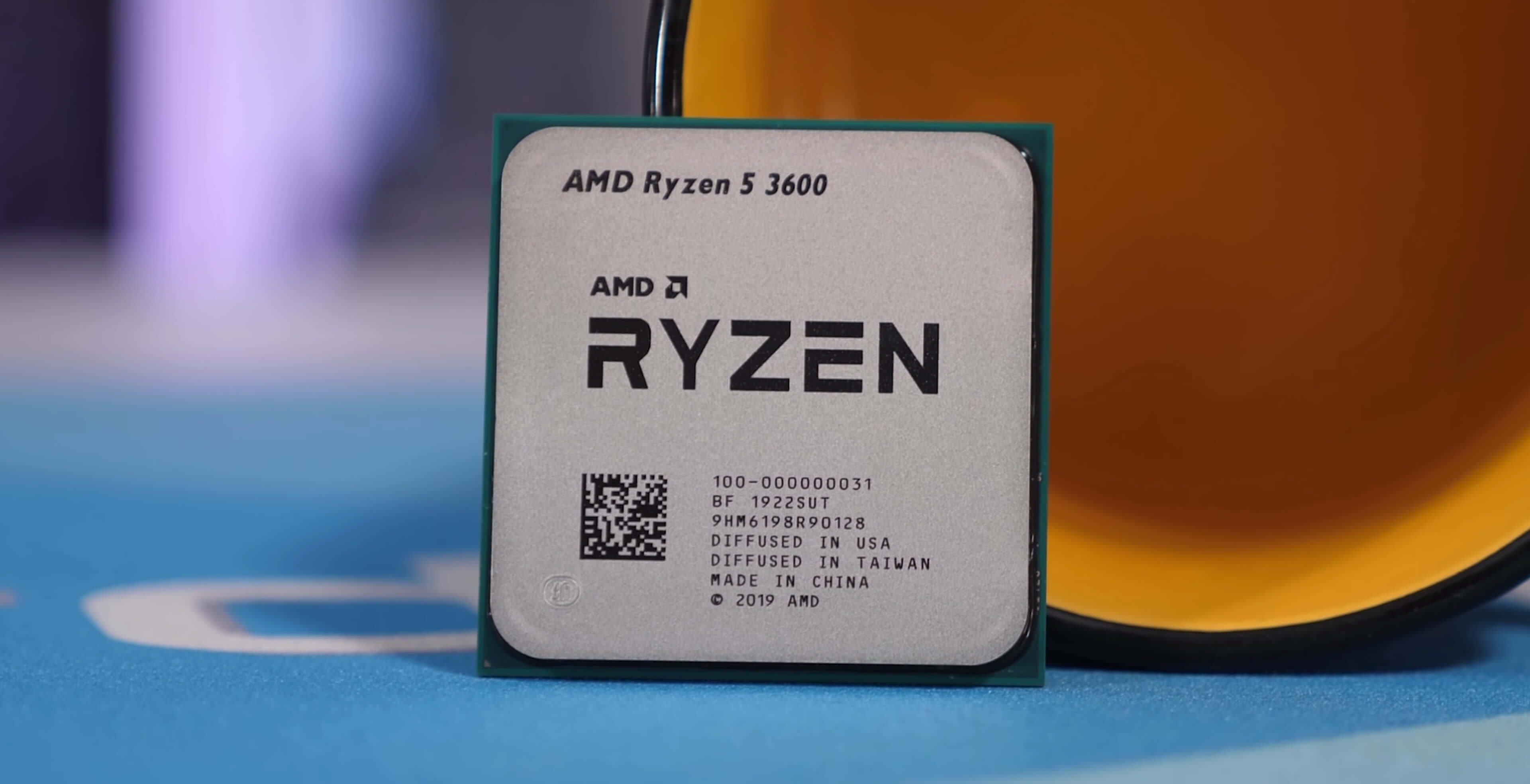Last August after much demand I locked myself away for a few days to benchmark... Just to be clear, no one requested I had to be locked away, but that's just what it took in order to get all 900 benchmark runs done. With the release of 3rd-gen Ryzen many gamers wanted a detailed GPU scaling benchmark. That's what we set out to deliver, testing four GPUs with three different CPUs at two resolutions, three quality presets, and four games.
The goal was to see how the most affordable new Ryzen (R5 3600) and then most expensive 3rd-gen processor (R9 3900X) compared to the Core i9-9900K, the world's best gaming CPU. In short, the Ryzen 5 3600 proved to be the best value option for gamers, more often than not matching the Ryzen 9 3900X. Using an RTX 2080 Ti with medium quality settings at 1080p, the affordable Ryzen was just 14% slower on average when compared to the 9900K.
However with a more reasonable GPU such as the $350 Radeon RX 5700 at 1440p with ultra quality settings, the Ryzen 5 processor was just 4% slower than the 9900K, while averaging over 120 fps.
Since then we've seen our fair share of new CPUs and other hardware that had to get reviewed and tested, but we've been sitting for weeks on similar scaling results and data comparing the excellent Ryzen 5 3600 against its predecessor, the Ryzen 5 2600 which is to this day a great value CPU option.
Gamers asking if they should spend ~$70 more on the R5 3600, or just get the 2600, this is the article for you. It was time to get these results out.
For testing, both AMD CPUs were paired with G.Skill DDR4-3200 CL14 memory and the Corsair H115i Pro cooler. Auto overclocking features such as MCE or PBO were disabled and the memory was not tuned, just XMP loaded. In other words, we're looking at out of the box performance with a quality all-in-one cooler and low latency memory. Let's get into the results.
Benchmarks
Starting with Assassin's Creed Odyssey at 1080p using medium quality settings, at the top of the graph we have the RTX 2080 Ti and here we see the 3600 is up to 28% faster than the 2600.
That's a big performance jump and those with high refresh rate monitors will certainly notice this improvement. However, if you're using a $500 graphics card with these $200 (or less) CPUs, then the margins are far less extreme. Here the 3600 was just 13% faster when comparing the average frame rate while the 1% low performance was almost identical.
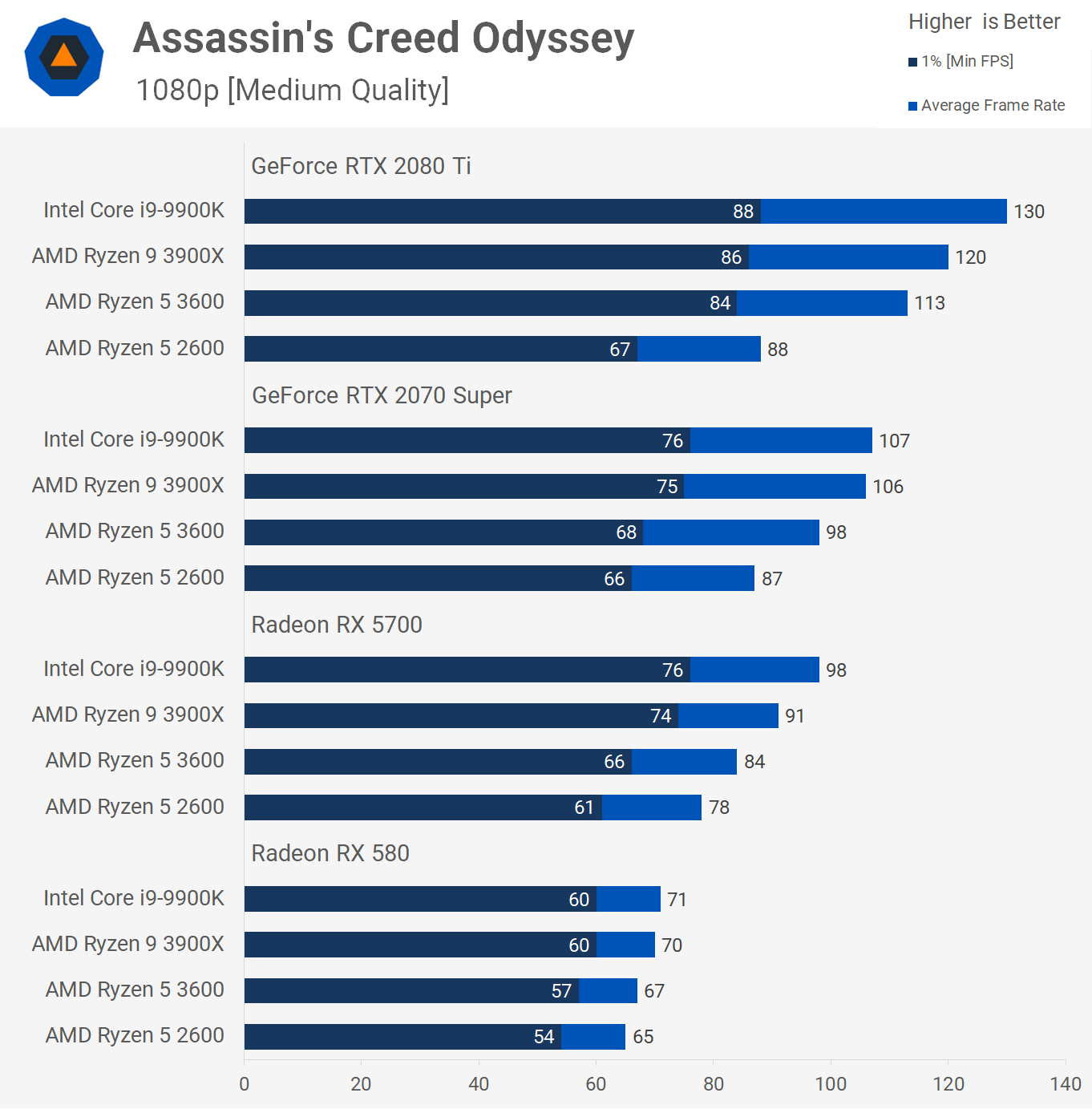
With more mainstream GPUs, like the $350 Radeon RX 5700, the 3600 is just 8% faster. Finally for those using an RX 580 or a GPU of roughly equivalent performance, there's virtually no difference between the 2600 and 3600 under these test conditions.
This will also of course be true of anyone using a GPU that's slower than the RX 580.
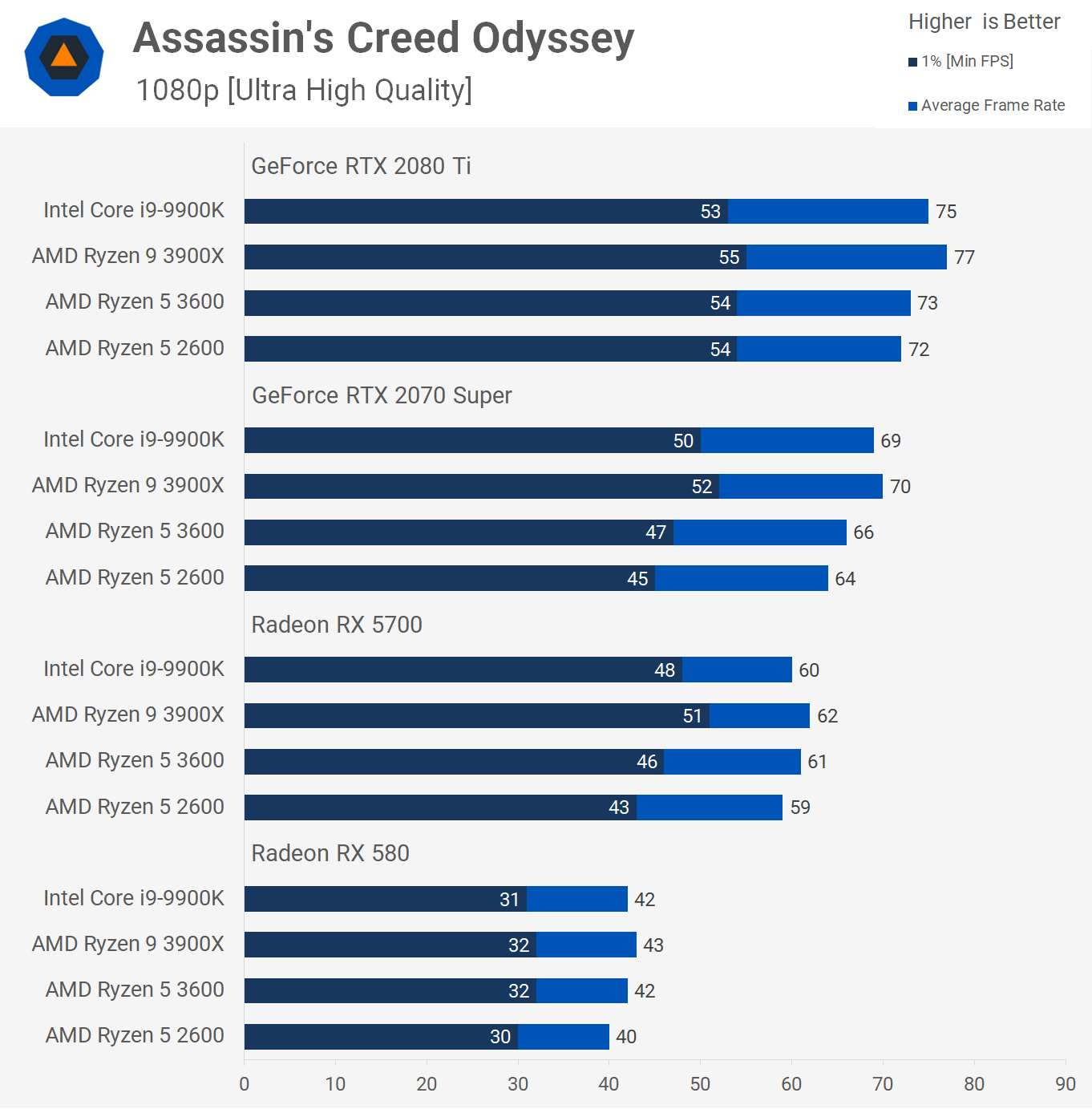
Now if we change the quality preset from medium to ultra high, things change quite a bit and this is a more appropriate quality setting for those using an RTX 2080 Ti, especially at just 1080p. Here we see virtually no difference in performance between the 2600 and 3600 using the 2080 Ti, in fact the 2600 was just a few frames slower than the 9900K in this test scenario.
It's a similar story with the RTX 2070 Super and RX 5700. At most the Ryzen R5 2600 was 3 fps slower than the 3600, delivering identical performance. Naturally we'll see the same result with the RX 580 and with slower GPUs as well.
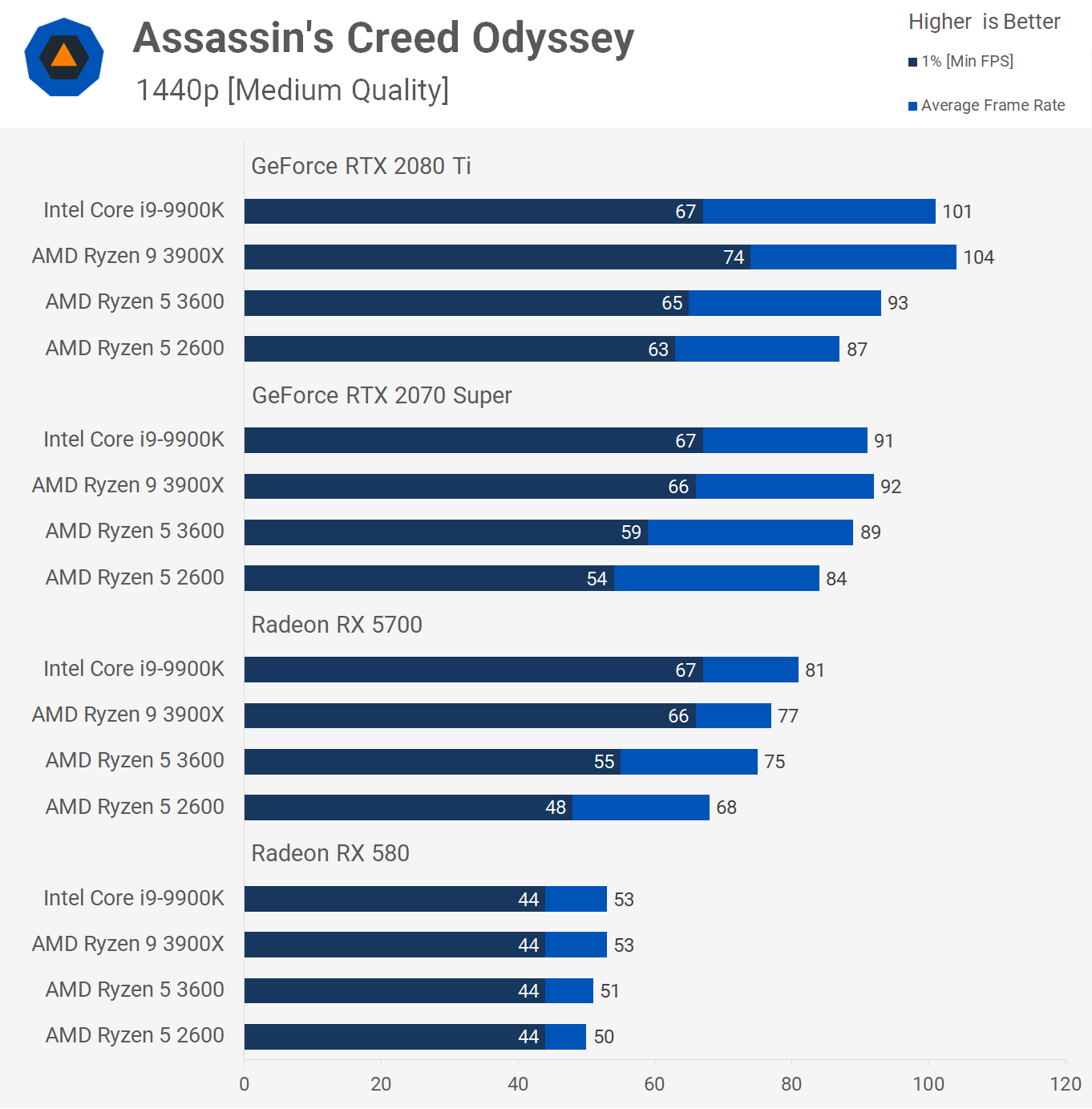
Jumping to 1440p using medium quality settings changes the picture from what we saw at 1080p. Previously, the 3600 was up to 28% faster than the 2600, here it's just 7% faster with the 2080 Ti.
Similar margins are seen when testing with the RTX 2070 Super and RX 5700, while we see virtually no performance difference with the RX 580.
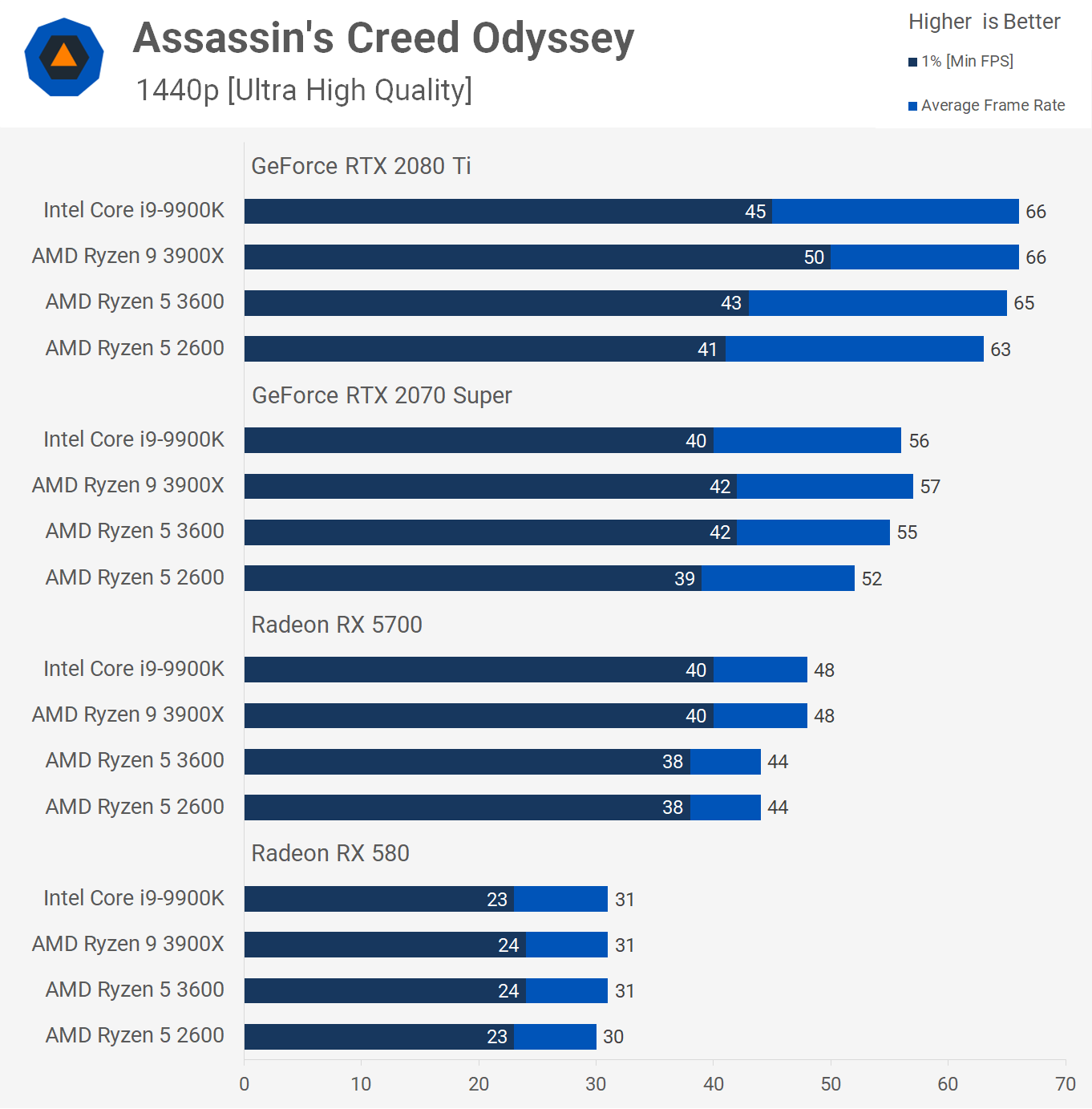
The final ACO test takes place at 1440p with the ultra high quality preset. Just as we found at 1080p using this preset, there's virtually no difference in performance between the 2600 and 3600. Even with the 2080 Ti we're heavily GPU limited under these test conditions.
Far Cry New Dawn
We've included this title deliberately as it represents the kind of performance you're likely to see in older games. This is also a title that caused performance issues for Ryzen processors, at least performance limiting issues.
Overall performance was still quite good and certainly smooth and very playable as we see here with the Ryzen 5 2600.

When using the normal or medium quality preset we see that the R5 3600 is 15% faster at 1080p with the RTX 2080 Ti, 2070 Super and even the RX 5700.
Even with the RX 580 we see some performance improvement over the 2600 here.

Increasing the quality settings places additional load on the CPU, as well as the GPU, and as a result the margin between the 2600 and 3600 increases, now the 3rd-gen hexa-core processor is up to 29% faster with the 2080 Ti, and similar margins are also seen with the 2070 Super and RX 5700.
Again, it's not until we drop down to the RX 580 that the margins are neutralized.

The margins at 1440p with the medium preset are slightly increased. Here the 3600 was 18% faster than the 2600 with the RTX 2080 Ti, previously we were seeing a 15% margin.
The 2070 Super and RX 5700 results are similar until we drop to the sub-$200 RX 580 that we become GPU bound and all CPUs are limited to the same level of performance.

Increasing the resolution widens the margins. At 1440p with the ultra quality preset enabled the 3600 was up to 27% faster than the 2600. This is seen with the 2080 Ti, 2070 Super and RX 5700.
Tom Clancy's Rainbow Six Siege
When testing Rainbow Six it should be noted that the "medium" quality setting is somewhat closer to 'high' as there's also 'very high' and 'ultra high' above it. So using the high quality preset at 1080p with a manually adjusted render scale of 100%, the Ryzen 3600 was up to 26% faster than the 2600 with the RTX 2080 Ti.
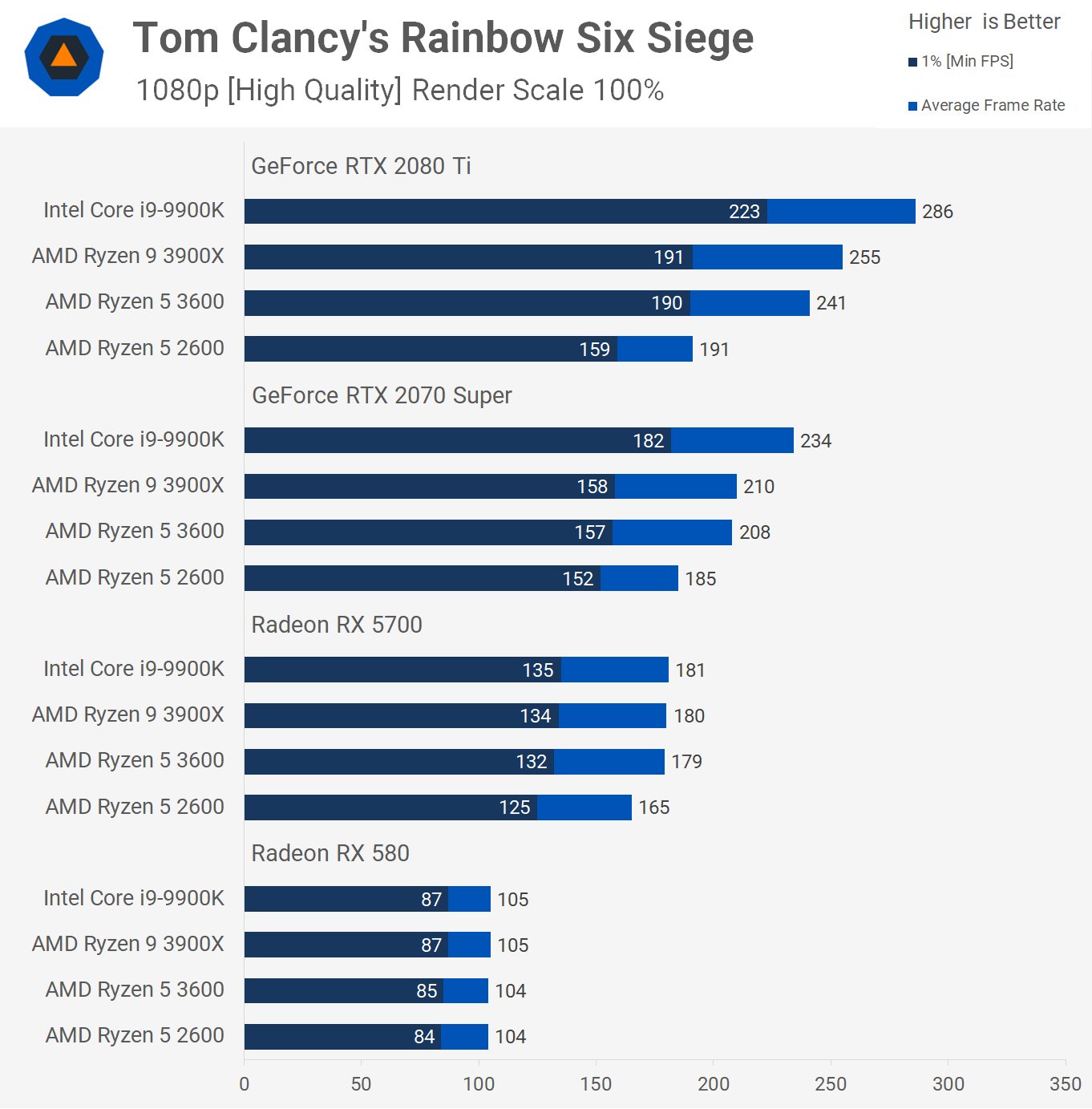
That margin is reduced to just 12% with the 2070 Super, though more crucially, the 1% low is almost identical across the 2600, 3600 and even the 3900X.
By the time we get down to the RX 5700 the 3600 is only ~8% faster and even the 9900K is delivering a similar level of performance.
Unsurprisingly the RX 580 sees all four CPUs deliver the same level of performance.

Testing again at 1080p, but this time with the ultra quality settings, the R5 3600 is still a good bit faster when paired with the RTX 2080 Ti, delivering 24% more frames on average.
However as we saw with the medium quality preset, using the RTX 2070 S greatly reduces the margin to the point where they are almost on par. The margin with the RX 5700 is basically non-existent and is eliminated completely with the RX 580, which mind you is almost pushing 100fps on average.
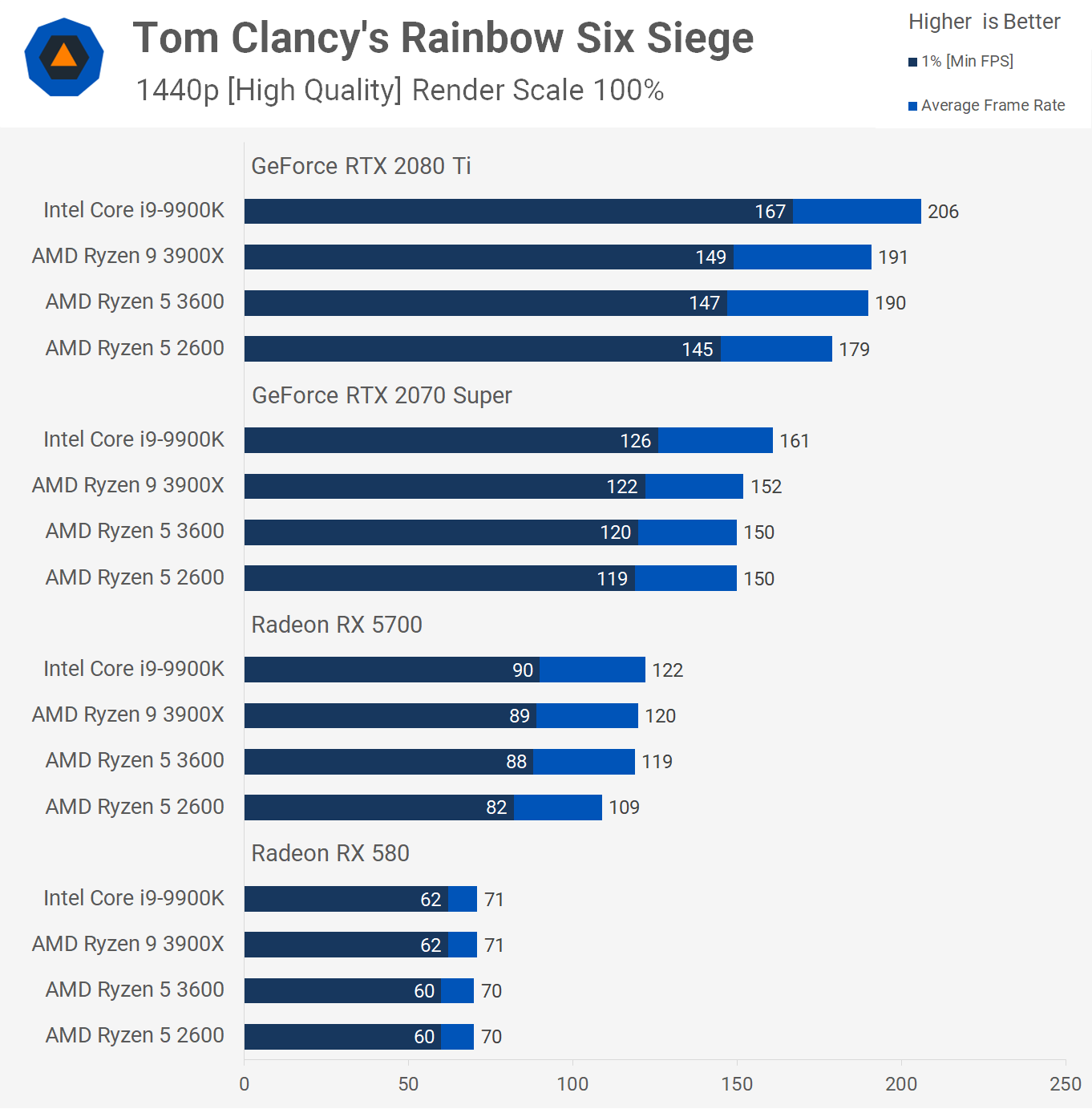
Previously at 1080p with the medium quality preset the 3600 was up to 26% faster than the 2600 when paired with the RTX 2080 Ti. This time using the same quality preset but at 1440p, we find that the 3600 is just 6% faster when looking at average frame rates, while the 1% low performance is virtually identical.
We see the same performance with the RTX 2070 Super, though interestingly the 2600 does drop off the pace a little when paired with the RX 5700.

The last Rainbow Six Siege test takes place at 1440p with the ultra quality settings and here the Ryzen 5 2600 still allowed for over 160 fps on average with the RTX 2080 Ti. In short, the 3600 and 2600 delivered identical performance with all four tested graphics cards.
World War Z
Moving on to World War Z, first we have the medium quality results at 1080p. Using the RTX 2080 Ti the 3600 was 24% faster than the 2600 when comparing 1% low performance. That said, the 2nd-gen part was still pushing over 100 fps at all times.

Dropping down to the RTX 2070 Super reduced the margin to 19%, but the 2600 was still pushing well over 100 fps. Surprisingly with the RX 5700 installed, the R5 3600 was up to 22% faster, so a decent performance uplift.
Even with the RX 580 we see that the 3600 is up to 9% faster, something we've not seen in the other games tested, though none of the other titles saw frame rates exceed 150 fps.

Increasing the quality preset to ultra reduced the 3600's lead over the 2600 with the RTX 2080 Ti down from 24% to 18%, not a massive change, but we are slightly more GPU limited here. Similar margins were also seen when testing with the RTX 2070 Super and RX 5700.
The trend is clear, it's not until we drop to the budget RX 580 that the margins close up, but even here the 2600 lags a little behind the 3600.
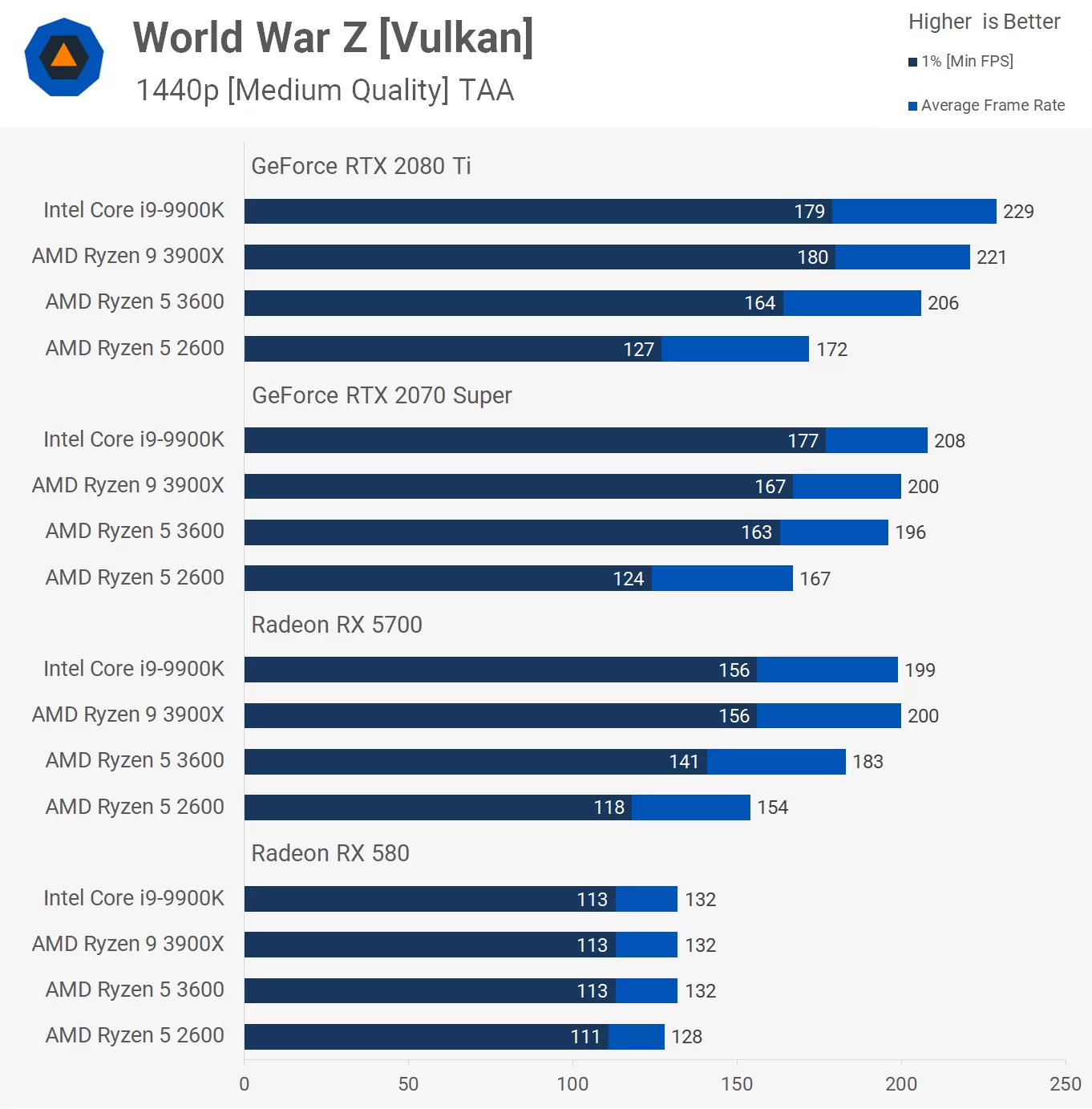
Once again we see that increasing the resolution actually increases CPU load and as a result the 3600 is up to 29% faster than the 2600 with the 2080 Ti at 1440p. The margin is reduced to 19% with the RX 5700 and then just 3% with the RX 580.

Finally at 1440p/Ultra we see that the 3600 is up to 23% faster than the 2600 when using the RTX 2080 Ti. That margin is reduced to 17% with the 2070 Super and then back up to 20% with the RX 5700. With the RX 580 we're looking at GPU limited frame rates and thus identical performance across all four tested CPUs.
Performance Summary
As we mentioned in the feature preceeding this, we realize four games is not a lot, but it took almost 300 benchmarks runs just to add the Ryzen 5 2600 into this comparison. The games used should also cover most performance scenarios. That being the case, what does the average performance look like?
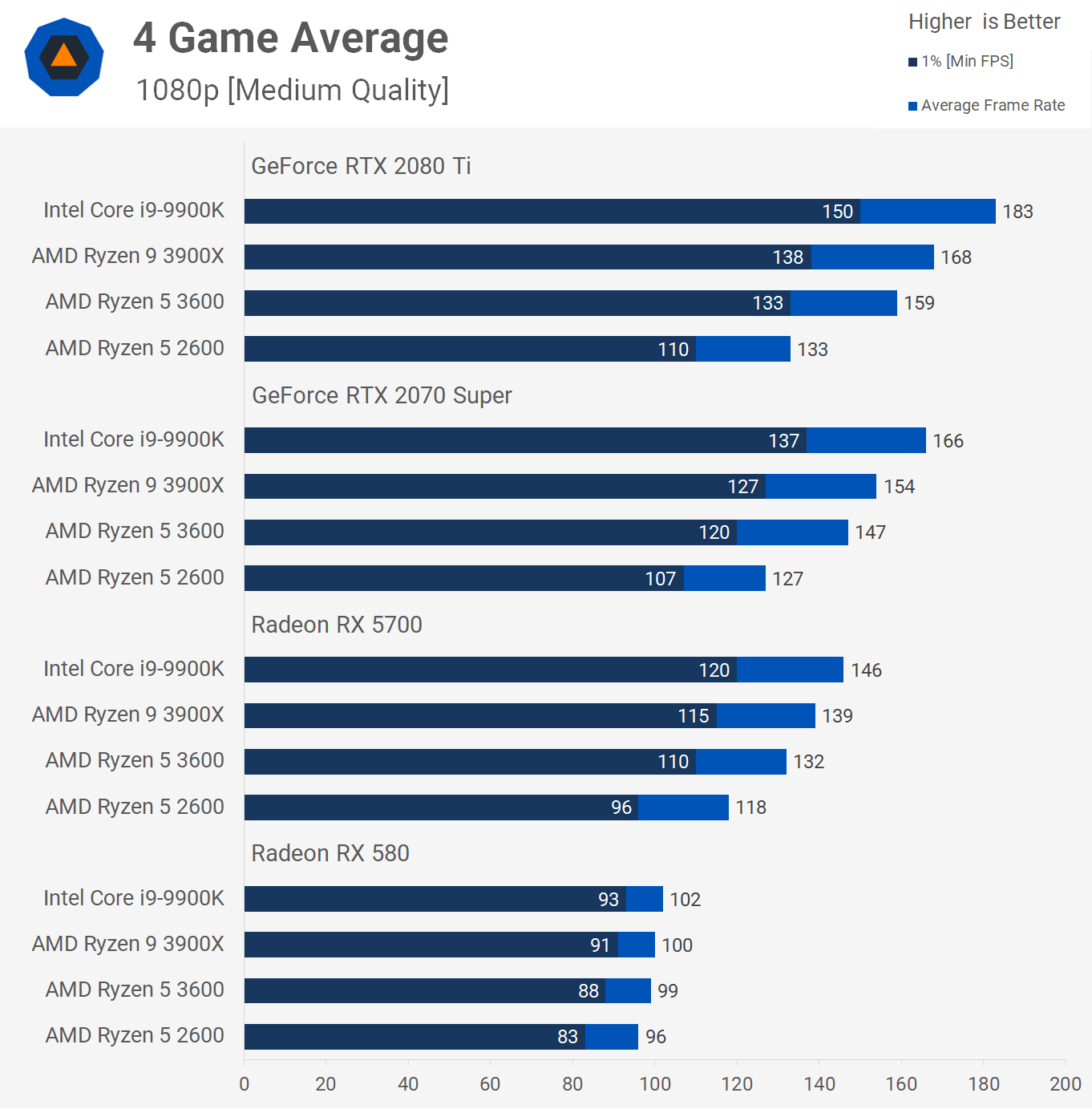
For those gaming at 1080p, using medium quality settings, with an RTX 2080 Ti... you're insane. But seriously, in this worst-case scenario for the Ryzen 5 2600 we see that the newer Ryzen 3600 was on average 21% faster.
For those using a $500 GPU under these conditions, you're still a little nutty, but in any case the 3600 was 16% faster on average with the 2070 Super.
We feel a more realistic pairing would be the Radeon RX 5700 and here the 3600 was just 12% faster on average, or 15% if we look at the 1% lows. Finally, if you're using an RX 580 or slower, the 3600 is really no faster than the 2600.
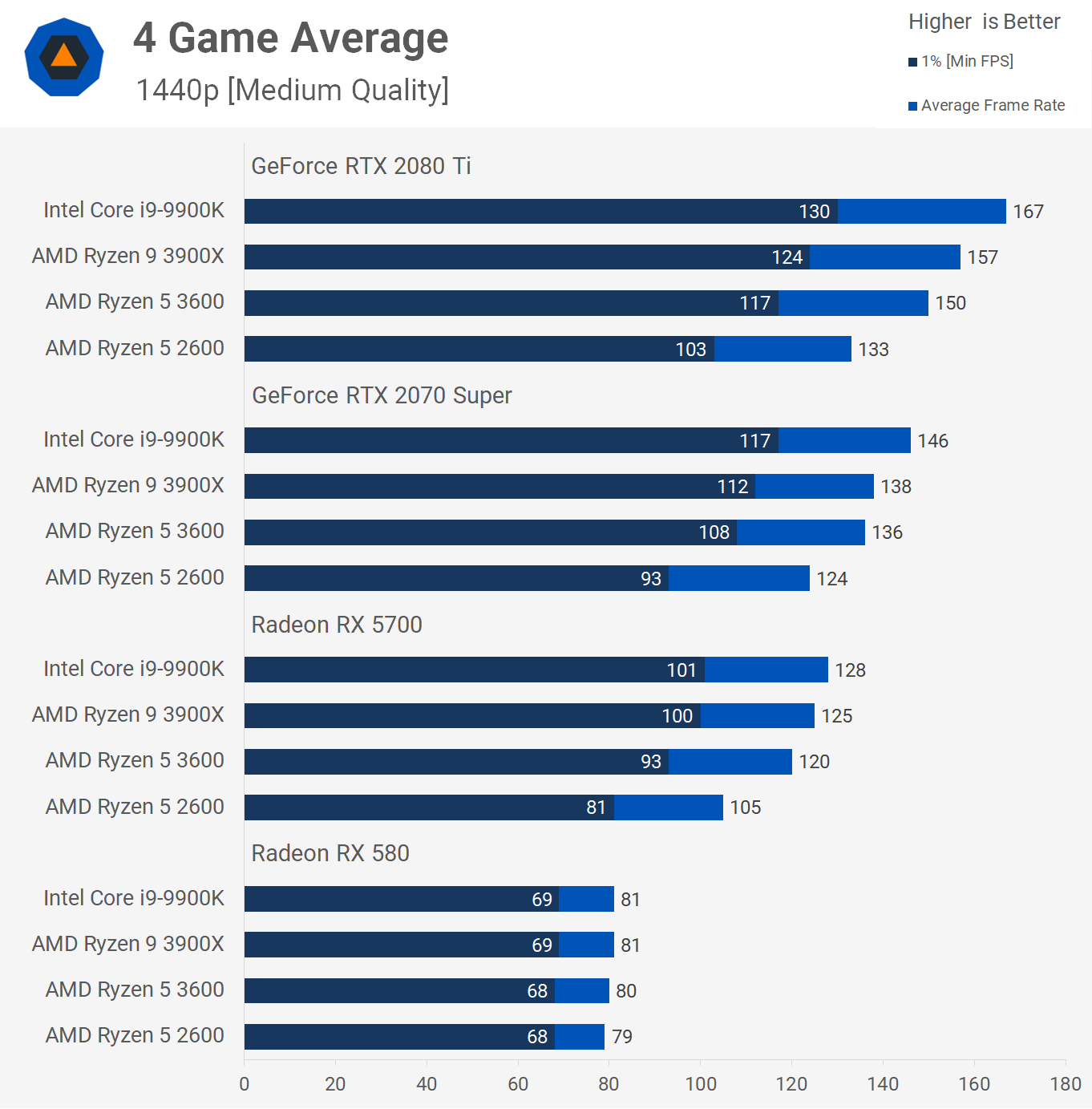
Now if we increase the resolution to 1440p which I feel is a more realistic choice with medium quality settings, even for RX 580 owners, we see that the 3600 is just 13% faster on average with the mighty RTX 2080 Ti, so not exactly a big gain over the 2600.
Similar margins are seen when testing with the 2070 Super and RX 5700, so you're looking at less than 20% performance improvement with the Ryzen 5 3600 over the 2600.
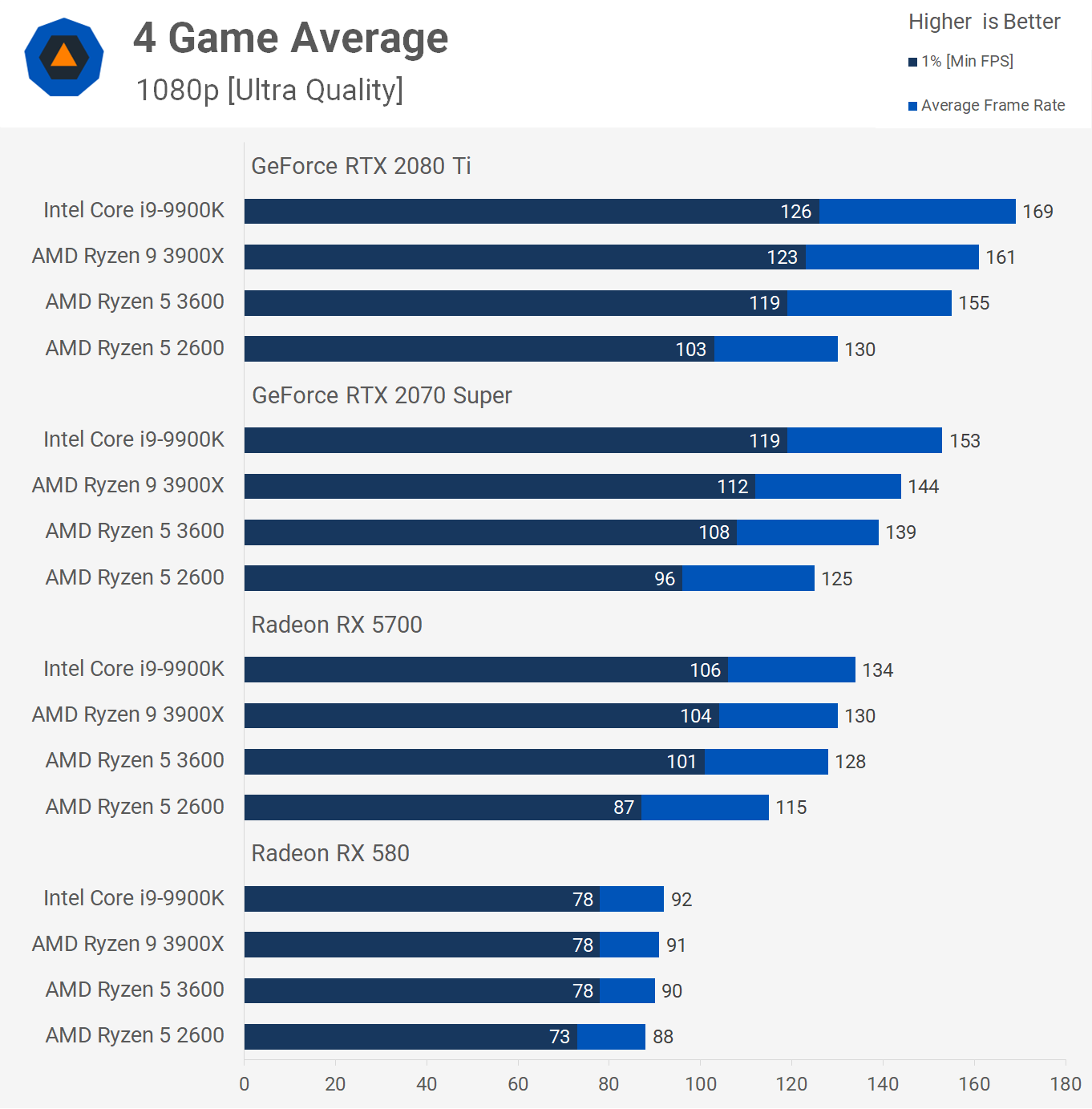
Using ultra quality settings, the 3600 was 19% faster on average with the 2080 Ti. That margin is reduced to just 13% with the 2070 Super and 16% with the RX 5700. Then for RX 580 owners you're looking at a 7% increase on average for the 1% low performance.

On a more demanding setting, gaming at 1440p, the Ryzen 3600 was on average 14% faster with the RTX 2080 Ti, 12% faster with the 2070 Super and 15% faster with the RX 5700. We see virtually no performance difference with the RX 580.
What We Learned
In our original Ryzen 5 3600 review which in addition to workstation and productivity tests included a 9-game benchmark covering 1080p and 1440p performance, we found when looking at just the 1080p numbers that on average the 3600 was 14% faster than the 2600. At the time the 2600 was retailing for $150 and the R5 3600 debuted at $200, meaning the older 2nd-gen part came in at a 15% discount per frame.
Looking at the best case average performance for the Ryzen 3600 in today's test, it was 21% faster with medium quality settings at 1080p. Worst case the 3600 was 12% faster at 1440p with ultra quality settings.
What has changed more dramatically perhaps is pricing. Today the Ryzen 5 2600 can be purchased new for just $120, while the 3600 costs $195, making the newer part 63% more expensive. In other regions this margin will vary, but in Australia for example, the pricing remains very similar.
If you're after maximum value and the best possible cost per frame, get the Ryzen 5 2600 or perhaps the new 12nm Ryzen 5 1600, which we plan to test soon. If you're after maximum fps for $200 or less, then get the Ryzen 5 3600, there are instances where it's almost 30% faster.
Do note that looking at this strictly from a cost per frame perspective doesn't factor in the cost of a motherboard, memory, or the rest of the system. An additional $75 expense on the CPU is a massive 63% increase, but if we're talking about a $1,000 system, it's less than 10%.
Granted, if you applied the same mentality to all the components in your system you'd end up well over budget... $70 more for the CPU, a tad more for the graphics card, more memory, better motherboard, more storage, and before you know it that $1,000 build is looking more like $1,500. In any case, the point of this kind of test is to learn the actual differences in performance, so you only spend on a more expensive component that will net you a noticeable increase in performance. Otherwise, save the $75 and put it towards an upgrade in a few years' time, at which point you should be able to buy a noticeable performance improvement.
Bottom line, the Ryzen 5 3600 is clearly the faster processor and we love it for the solid performance it offers for gaming and productivity tasks. But if you're looking to get the most bang for your buck, the discounted 2nd-gen parts are the way to go.
